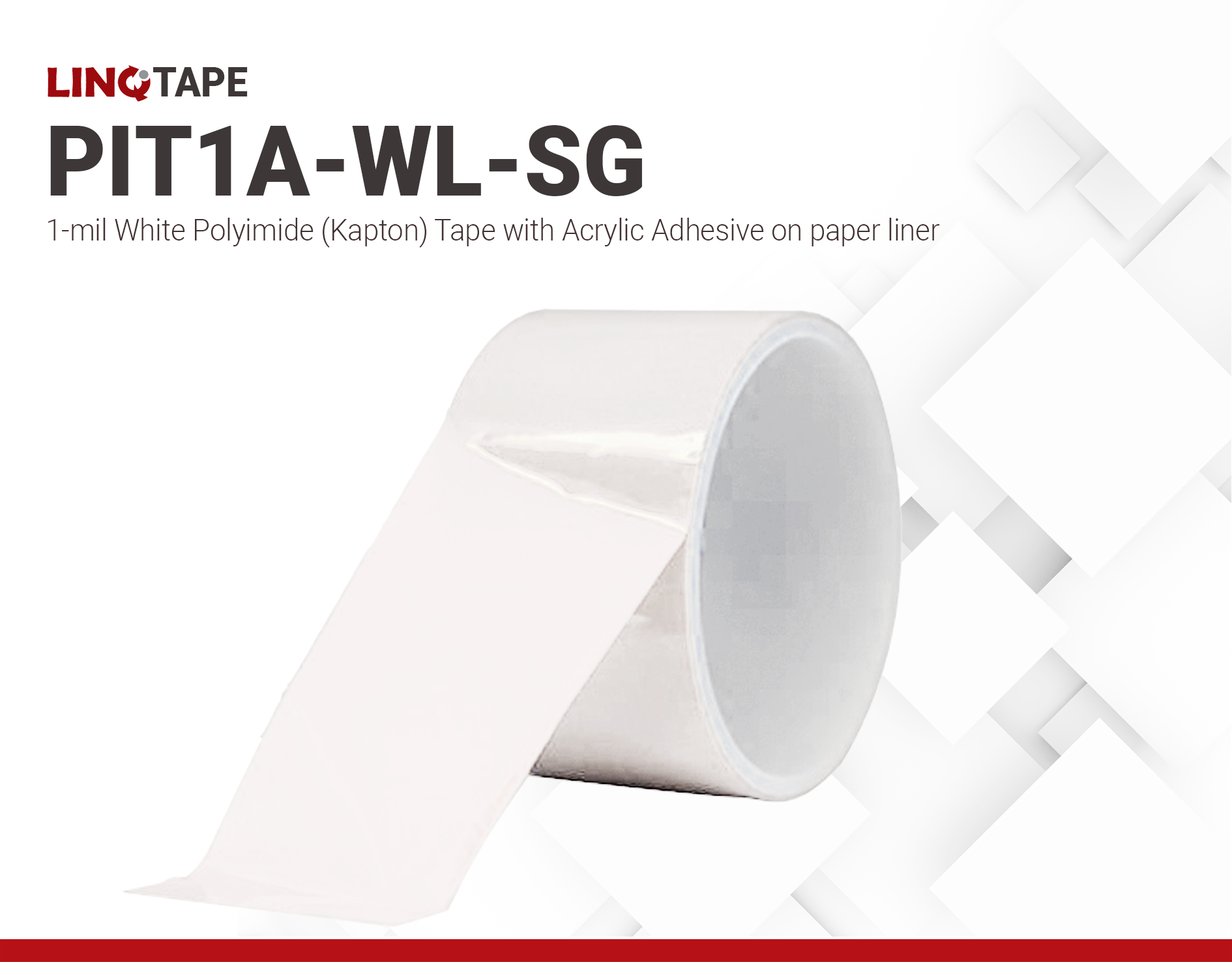PIT1A-WL-SG | 1-mil White Polyimide (Kapton) Tape with Acrylic Adhesive
Harmonization Code : 3919.90.80.99 | Polyacrylic plates / sheets / film / tape / strip, self-adhesive, in rolls
Main features
- 1 mil polyimide film
- Acrylic adhesive
- White-labeled
Product Description
LINQTAPE PIT1A-WL-Series is a Kapton Tape Alternative used for thermal printing. It provides an excellent balance of electrical, mechanical, thermal, and chemical properties over a wide range of temperatures (-40 to 572 °F). It can be used in applications that require thermal printing on parts that can withstand high temperatures, such as steel or other alloys.
LINQTAPE™ PIT1A-WL-SG is a white top coated high-temperature resistant polyimide film, with a one-sided aggressive acrylic adhesive, and backed with a Kraft liner. The tape complies with RoHs and Reach requirements.
Application Ideas
- Label and bar code making
- Marking electronic components
- Thermal printing
Technical Specifications
| Thermal Properties | |
| Temperature Resistance Temperature Resistance Temperature resistance is the maximum temperature that the material or product can withstand for a period of time. The temperatures listed should be considered as guidelines for an operating temperature of about 30 minutes. Typically, the material can withstand much longer times at temperatures about 20°C lower and can withstand much higher temperatures for short, intermittent times. | 300 ˚C |
| Electrical Properties | |
| Breakdown Voltage Breakdown Voltage Breakdown voltage is the minimum voltage necessary to force an insulator to conduct some amount of electricity. It is the point at which a material ceases to be an insulator and becomes a resistor that conducts electricity at some proportion of the total current. After dielectric breakdown, the material may or may not behave as an insulator any more because of the molecular structure alteration. The current flow tend to create a localised puncture that totally alters the dielectric properties of the material. This electrical property is thickness dependent and is the maximum amount of voltage that a dielectric material can withstand before breaking down. The breakdown voltage is calculated by multiplying the dielectric strength of the material times the thickness of the film. | 6000 V |
| Other Properties | |
| RoHS Compliant RoHS Compliant RoHS is a product level compliance based on a European Union Directive which restricts the Use of certain Hazardous Substances in Electrical and Electronic Equipment (RoHS). Products compliant with this directive do not exceed the allowable amounts of the following restricted materials: lead, mercury, cadmium, hexavalent chromium, polybrominated biphenyls (PBB) and polybrominated diphenyl ethers (PBDE), with some limited exemptions | Yes |
| Mechanical Properties | |
| Adhesion Strength Adhesion Strength Adhesion is the bond strength measurement of a coating to a substrate. When an adhesive is bonded to an item or surface, numerous physical, mechanical and chemical forces come into play, which may have an effect on each other. | 25 Oz/in |
| Elongation Elongation Elongation is the process of lengthening something. It is a percentage that measures the initial, unstressed, length compared to the length of the material right before it breaks. It is commonly referred to as Ultimate Elongation or Tensile Elongation at break. | 40 % |
| Tensile Strength (Thin Film) Tensile Strength (Thin Film) Tensile strength determines the resistance of a material to break under tension and it measures how much elongating load (or tensile stress) it can handle before fracture. To make it simple, it measures how much force we have to apply when pulling apart a material before it breaks. | 52 N/cm |
| General Properties | |
| Adhesive Thickness Adhesive Thickness Adhesive thickness indicates the thickness of an adhesive layer. It refers to the adhesive thickness of a single side so for double sided tapes it always needs to be multiplied. | 38.1 µm |
| Chemistry Type | Polyimide |
| Color Color The color | White |
| Film Thickness Film Thickness Film thickness is the thickness of a backing film without taking into account any coatings or adhesive layers. It is measured in micron and the conversion factor to mil is 0.039. | 25.4 µm |
| Release Liner Release Liner A paper or plastic-based film sheet used to prevent a sticky surface from prematurely adhering | Kraft |
| Single or Double-Sided Adhesive Single or Double-Sided Adhesive Describes whether a tape is single- or double-sided. If it is single-sided, it has adhesive only on one side of the backing film. If it is double-sided, then it has adhesive on both sides of the backing film. | Single-Sided |
| Special Layer | Thermal Ink Print Layer |
| Total Thickness Total Thickness Total thickness is taking into account all the films, coatings, adhesives, release liners and special layers and is the maximum thickness of a film or tape. | 63.5 μm |



